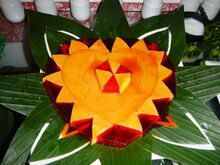Gulaman
Topic: Chemistry
 From HandWiki - Reading time: 3 min
From HandWiki - Reading time: 3 min
 A dessert made from leche flan and gulaman from Baliuag, Bulacan | |
| Course | Dessert |
|---|---|
| Place of origin | Philippines |
| Serving temperature | Cold |
| Main ingredients | Agar |
Gulaman, in Filipino cuisine, is a bar, or powdered form, of dried agar or carrageenan used to make jelly-like desserts. In common usage, it also usually refers to the refreshment sago't gulaman, sometimes referred to as samalamig, sold at roadside stalls and vendors.[1]
History
Gracilaria, which produces agar, is known as gulaman or gulaman dagat in Tagalog. It has been harvested and used as food for centuries, eaten both fresh or sun-dried and turned into jellies. The earliest historical attestation is from the Vocabulario de la lengua tagala (1754) by the Jesuit priests Juan de Noceda and Pedro de Sanlucar, where golaman or gulaman was defined as "una yerva, de que se haze conserva a modo de Halea, naze en la mar" ("an herb, from which a jam-like preserve is made, grows in the sea"), with an additional entry for guinolaman to refer to food made with the jelly.[2][3]
Gulaman can also be made from Eucheuma spp., which produces the similarly jelly-like carrageenan. Eucheuma is known as gusô or tambalang in the Visayan languages. Use of gusô to make jellies among the Visayans have been recorded in the even earlier Diccionario De La Lengua Bisaya, Hiligueina y Haraia de la isla de Panay y Sugbu y para las demas islas (c. 1637) of the Augustinian missionary Alonso de Méntrida (in Spanish). In the book, Méntrida describes gusô as being cooked until it melts, and then allowed to congeal into a sour dish.[4]
Description
Gulaman is the Filipino culinary use of agar, which is made of processed Gracilaria seaweed;[5] or carrageenan derived from other farmed seaweed species like Eucheuma and Kappaphycus alvarezii, which were first cultivated commercially in the Philippines.[1][6][7][8]
It is usually sold dehydrated and formed into foot-long dry bars, which are either plain or coloured.[9] It is also commonly sold in powder form.[10]
Uses
Gulaman bars are used in the various Filipino refreshments or desserts such as sago at gulaman, buko pandan, agar flan, halo-halo, fruit cocktail jelly, different varieties of Filipino fruit salads, black gulaman, and red gulaman.
Differences between gelatine and gulaman
The term gelatine (or "jelly") and gulaman are used synonymously in the Philippines , although they are very different products. While gelatine is an animal-derived protein, gulaman is a plant-derived carbohydrate[11] made from seaweed. This distinction makes gulaman suitable for those who may not eat gelatine for religious or cultural reasons, such as for Muslims or vegans.
Gelatine dissolves in hot water but boiling water is necessary to dissolve gulaman. Unlike gelatine which sets at refrigerator temperature, gulaman sets at room temperature. While gelatine can melt at room temperature, it is uniquely thermo-reversible[11] to its previous shape and form.
See also
- List of Philippine desserts
- Chondrus crispus
- Kaong
- Nata de coco
- Sago
- Tapioca balls
References
- ↑ 1.0 1.1 Montaño, Marco Nemesio (September 16, 2004). "Gelatin, gulaman, 'JellyAce,' atbp.". PhilStar Global. https://www.philstar.com/business/science-and-environment/2004/09/16/264974/gelatin-gulaman-145jellyace146-atbp.
- ↑ Albert H. Wells (1916). "Possibilities of Gulaman Dagat as a Substitute for Gelatin in Food". The Philippine Journal of Science 11: 267-271.
- ↑ de Noceda, Juan; de Sanlucar, Pedro (1754). Vocabulario de la lengua Tagala. Imprenta de la compañia de Jesus. p. 101, 215.
- ↑ de Mentrida, Alonso (1841). Diccionario De La Lengua Bisaya, Hiligueina Y Haraya de la isla de Panay. En La Imprenta De D. Manuel Y De D. Felis Dayot. p. 380.
- ↑ "Gulaman". Philippine Medicinal Plants. http://www.stuartxchange.org/Gulaman.html.
- ↑ Buschmann, Alejandro H.; Camus, Carolina; Infante, Javier; Neori, Amir; Israel, Álvaro; Hernández-González, María C.; Pereda, Sandra V.; Gomez-Pinchetti, Juan Luis et al. (October 2, 2017). "Seaweed production: overview of the global state of exploitation, farming and emerging research activity" (in en). European Journal of Phycology 52 (4): 391–406. doi:10.1080/09670262.2017.1365175. ISSN 0967-0262.
- ↑ Impact Investment for a Business Venture for Community-Based Seaweed Farming in Northern Palawan, Philippines. Blue Economy Impact Investment East Asia & Partnerships in Environmental Management for the Seas of East Asia. 2017. http://seaknowledgebank.net/sites/default/files/Business%20Concept%20Community-based%20Seaweed%20Farming%20Philippines%20-%20FINAL_0.pdf. Retrieved February 8, 2021.
- ↑ Habito, Cielito F. (November 1, 2011). "Sustaining seaweeds". Philippine Daily Inquirer. https://opinion.inquirer.net/16365/sustaining-seaweeds.
- ↑ "Gulaman at Sago (Agar-Agar and Tapioca Pearls)". Lafang: a Pinoy food blog. July 13, 2006. http://lafang.mikemina.com/index.php/2006/07/13/gulaman-at-sago-agar-agar-and-tapioca-pearls/.
- ↑ "ZANG Gulaman". https://www.shireli-mfg.com/zang.
- ↑ 11.0 11.1 "Things you need to know about gelatine". Food Magazine-Philippines: 99. December 2006 – January 2007.
 |
 KSF
KSF
